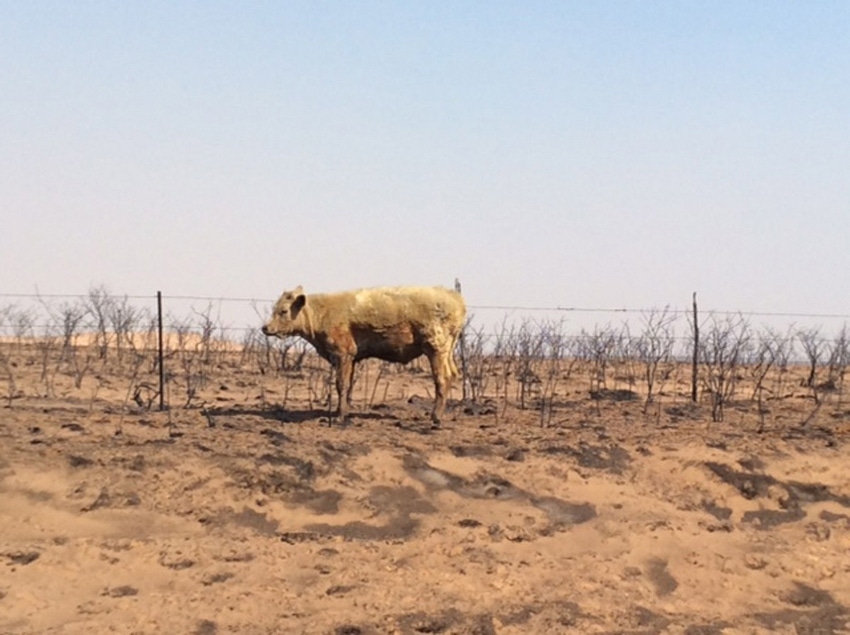
Wind-whipped wildfires raced across the Texas Panhandle March 6 and 7, leaving tragic human losses, as well as about 440,000 acres of charred land in eight counties, hundreds of miles of burned fences and uncounted number of dead or injured animals with the flames still moving.
Even as fires continue to burn across the Texas plains, the Texas A&M AgriLife Extension Service is working with county judges to request establishment of Livestock Supply Points in both Gray and Lipscomb counties to begin aiding producers who suffered losses, says Danny Nusser, AgriLife Extension regional program leader in Amarillo.
“We know there are animal death losses and the Texas Animal Health Commission and Texas Commission on Environmental Quality will take care of those issues; however, we also know people need help with their live animals right now,” Nusser said.
“We have livestock that are displaced and don’t have forages available to keep them fed. We are setting up two Livestock Supply Points to collect and disperse feed, hay, fencing, vet supplies and other donated items.”
AID SUPPLY POINTS
One supply point for those impacted in Ochiltree, Lipscomb, Hemphill and Roberts counties will be located at 202 W. Main St., Lipscomb. The point of contact is J.R. Sprague, AgriLife Extension agent in Lipscomb County, who can be contacted at 806-862-4601, office, or 806-202-5288, cell.
A second supply point serving ranchers in Gray, Wheeler and Roberts counties will be at 301 Bull Barn Drive, Clyde Carruth Expo Center, Pampa. Mike Jeffcoat, AgriLife Extension agent in Gray County, is the point of contact and can be reached at 806-669-8033, office, or 580-467-0753, cell.
Anything donated will be used to offset the mounting expenses the fire damage will cause for producers caught in its path, said Dr. Steve Amosson, AgriLife Extension economist.
Amosson said several cost factors are related to wildfire losses, starting with the cost of lost cattle, at about $1,300 per cow-calf pair, and then millions of dollars in needed fence repairs. He estimated the cost is $10,000 a mile for a four- to six-wire fence with steel posts.
He adds the expense of feed for displaced livestock, plus any costs that might be associated with disposal of animals that perished in the fire.
CONTACTS FOR HELP
Texas Animal Health Commission provided the following list of contacts for producers with questions about lost or found animals, as well as disposal of carcasses:
– For found cattle or other livestock with official identification, document the number and location of the animals and call the Texas Animal Health Commission at 512-719-0733 or 806-354-9335. They will contact the owner.
– For stray cattle with a brand, call the Texas Southwestern Cattle Raisers Association at 817-332-7064 for brand identification.
– In the event cattle stray onto your property, you must report them to the sheriff’s office in the county in which you are located within five days of discovery to be eligible for reasonable payment for maintenance or damages caused by the stray livestock. For more information regarding Texas’ stray laws visit: Texas Agriculture Code, Chapter 142.
– For questions about carcass disposal, call the Texas Commission on Environment Quality at 800-832-8224 or visit their website at www.tceq.texas.gov.
Dr. Ted McCollum, AgriLife Extension beef cattle specialist in Amarillo, says many cattle might have made it through the fires alive and need to be checked for injuries as soon as possible.
ANIMAL INJURIES
“It’s important to have them looked at by a veterinarian as soon as possible because there could be secondary problems that lead to infections and further problems,” McCollum said.
Health disorders such as burned eyes, feet, udders, sheaths and testicles, as well as smoke inhalation with lung inflammation and edema, are the most common problems, he said.
The fires came at a very inopportune time for ranchers who are beginning the calving season, McCollum said.
“We probably had a lot of calves that were laying out susceptible to the fire, as fast as it was moving across there,” McCollum says. “They had no place to go. Also there will be a lot of mothers with potentially scorched udders. The calves that survived won’t be able to suckle the mothers that have sore udders. Producers should be looking for bawling calves to provide replacement milk to or to sell to someone who can care for them.”
Animals that were not evacuated and remained in a fire danger zone, even if only for a short time, could suffer injuries. A fire-danger zone is the area where the livestock risk inhaling smoke, and changes according to the wind direction. Smoke can move for miles, and cattle that are not near the flames or heat could suffer some injury.
Contact with burning grass, weeds and brush causes immediate burns; however, inhalation of smoke causes immediate irritation to the lining of the respiratory system, including nasal passages, trachea and lungs. This can lead to inflammation, edema and emphysema, with the severity determined by the duration of inhaled smoke.
Once the fire has passed, a veterinarian should be consulted immediately for any animals with severe burns or direct smoke exposure. Other livestock should also be evaluated for possible health disorders and treatment or to determine if the animal can be salvaged for slaughter or should be euthanized, he said.
About the Author(s)
You May Also Like




